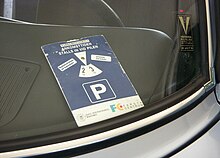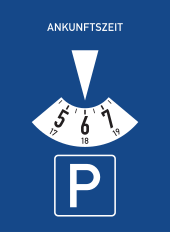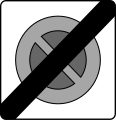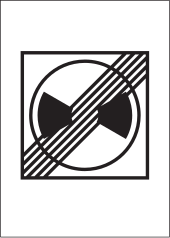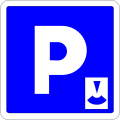Parking disc
A parking disc is used in road transport in the parking of vehicles to indicate the arrival time (of the parking start) of a motor vehicle on an as parking marked surface with monitoring the parking time.
The forerunner of today's regulations can be found in the designation of a blue zone in city centers - in this parking zone you could park for up to two hours free of charge with a corresponding (regionally different) parking disc. The current regulation with the standardized EU parking disc allows a further range of time restrictions, which are indicated on the parking lot signs.
Parking meters , for example, are used to monitor the parking duration in paid parking spaces .
history
A first parking disc-type system was introduced in Paris in 1957 to restrict long-term parking . It was conceived by the engineer Robert Thiebault and the police prefect Roger Genebrier.
Short-term parking in parts of Vienna's 1st district was introduced for the first time in Austria on March 16, 1959. At the same time it was decreed that drivers of motor vehicles have to put a parking disc behind the windshield. In this Viennese parking disc , the city did not take the systems of Paris and Salzburg as a model, but was by then Vienna Baudirektor Aladar Pecht the named after him Pechtscheibe designed: Two firmly connected pointer on a dial mounted, marked exactly the period of a Hour. The arrival time was set with one hand, the second inevitably indicated the permitted end of parking. Because of its similarity to a clock, the term parking meter was colloquial .
Kassel was the first German city to introduce the parking disc in 1961 on the initiative of the then police chief and later mayor of Kassel, Heinz Hille.
On May 31, 1979, the Conference of Transport Ministers of the European Community decided to introduce a uniform parking disc regulation. This should only contain a time. The nature of the corresponding parking disc was described in Germany in the Verkehrsblatt 1981 p. 447. The design was then adopted in other countries. The regulations on the "blue zone" were also replaced in France from 1998 and Switzerland from 2000 - their old parking discs were allowed to be used until 2003 in Switzerland and 2007 in France.
Legal regulations
Germany
The parking areas can be signposted by sign 314 ( parking lot ) or sign 315 ( parking on sidewalks ) and by an additional sign that requires the use of a parking disc, or by signs 290 and 292 ( restricted stopping zone) or 314.1 and 314.2 ( Parking management zone ). Since the time of the start of parking is displayed, the word arrival time is always to be read on the front of the parking disc. A single additional sign without the corresponding traffic sign above is not binding ( Section 39 (2 ) StVO ).
The time is set manually by turning the disc until the line with the corresponding information under the white triangle (arrow) shows the half hour following the actual arrival . The division of the scale intentionally only allows an accuracy of half an hour ( § 13 StVO). Setting on a white space is not permitted.
Example: If you arrive between 11:00 a.m. and 11:29:59 a.m. , the arrow on the parking disc must be set to the next line, i.e. 11:30 a.m., because at 11:30 a.m. the next half Hour that follows the time of the stop. If you arrive between 11:30 a.m. and 11:59:59 a.m., the disc must be turned to 12:00 p.m.
The parking disc is a traffic sign in Germany. Its symbol was first incorporated into law in 1971 with the introduction of the then road traffic regulations in the version of November 16, 1970 as symbol 291. Its current form and condition was defined in the traffic gazette no. 237 of November 24, 1981. The external dimensions are 150 mm high and 110 mm wide. The parking disc must be clearly visible in the vehicle so that the arrival time can be read from the outside. The parking disc has been listed as traffic sign 318 since 2013, or officially with the 2017 traffic sign catalog.
As a traffic sign of the road traffic regulations, parking discs in Germany must comply with the standards specified in the traffic gazette and must therefore comply with the legal minimum size established in 1981. In agreement with the legal situation, the Brandenburg Higher Regional Court ruled against a German driver who used an Italian parking disc (40 mm × 60 mm) in Germany that was much smaller and thus committed an administrative offense. As a traffic sign, the coloring and the prescribed font for parking discs must also be adhered to. A fine may be imposed if different models are used. To this end, it was stipulated in the traffic gazette as early as 1971: "Traffic signs that do not only correspond to the pictures in the annex to the StVO in small details (so-called fantasy signs) are regularly void ..."
In individual, special cases, the parking disc can also be used instead of a paid parking ticket. Thus, §13 Abs. 3 StVO provides that in the case of z. B. a defective parking ticket machine is to use a parking disc. In this case, the parking time is limited to the maximum parking time up to which you could have bought a parking ticket. Furthermore, in some German cities such. B. in Hamburg or Stuttgart, the drivers of marked electric vehicles (E-license plate) are allowed to only display the parking disc in an area that requires parking tickets and thus to park free of charge until the maximum parking time is reached. The legal basis of these regulations is § 3 of the Electric Mobility Act (EmoG) in connection with the respective decree of the local government.
Digital parking disc
Since 2005, the legislature in Germany has also allowed electronic alternatives for parking time monitoring. This change in the law primarily made cell phone parking possible, but also allows other variants. Since then, an electronic parking disc can be used if it is ensured that the clock stops accordingly.
The requirements for the digital parking disc differ from the conventional dimensions of a manual parking disc. The currently valid requirements for an electronic parking disc were published on November 30, 2013 in the official part of the Verkehrsblatt , the official gazette of the Federal Ministry for Transport, Building and Urban Development of the Federal Republic of Germany , and came into force on December 1, 2013. In Germany, the following criteria must be met:
- Type approval must be granted
- after the vehicle has been parked (the vehicle engine switched off or detection via motion sensors and GPS), it must automatically set itself for the next half an hour
- After activation, it must not change its setting and it must be secured against any tampering (the adjustment after activation of the motor by a remote control is also expressly excluded)
- on the front it bears a picture of the traffic sign 314,
- the word "arrival time" appears above the display,
- The display shows a 24-hour time with a number of at least 2 cm and
- it must be clearly legible from the outside without any doubt.
Austria
The first legal regulations on parking disks - commonly known as parking meters - were introduced in 1961.The parking disks with two pointers (black for the arrival time and red for the expiry time) and division into fifteen minutes are also valid according to the current version, although since 1994 only the black pointer is set ( Section 4 (3) Short-Term Parking Zone Monitoring Ordinance).
The current "Short-Term Parking Zone Monitoring Ordinance" deviates from the regulations on the blue parking disc in Germany and Switzerland insofar as it says in Section 4 (2):
"The pointer has to indicate the arrival time, whereby it can be rounded up to the full quarter of an hour following the time of parking."
In the event of an actual arrival at 10:01 a.m., the arrival time on the parking disc may be set to 10:15 a.m. The text of the law also gives rise to the different design of Austrian parking discs - with a pointer and a dial with quarter-hour markings (illustration in Appendix 1 of the law). As a precaution, an Austrian parking disc should not be used in Germany or Switzerland, and vice versa, it would be better not to use a German or Swiss parking disc in Austria. Although the employees of the parking area monitoring routinely recognize inappropriate parking discs with the correct setting, they cannot be invoked in the event of a penalty mandate.
- Excerpt from the illustration of the road signs in Austria
13d: Start of a short-term parking zone
Switzerland
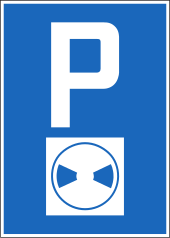
In Switzerland, a parking disc must be used at certain times in parking spaces marked with blue lines, even if no traffic sign explicitly indicates the use of parking discs. The setting of the arrival time works analogously to the requirements in Germany, i. H. in the event of an actual arrival at 10:01 a.m., the arrival time on the parking disc is set to 10:30 a.m. The Federal Roads Office explicitly shows that if the arrival time is exactly 11:00 a.m., the following line is set for 11:30 a.m.
On Sundays, parking spaces with a blue line are generally allowed without a parking disc, unless it is stated on an additional board that the parking disc must also be installed on Sunday. On working days (including Saturdays), parking spaces lined with blue are only allowed longer than one at lunchtime (more precisely: from 11:30 a.m. to 1:30 p.m.) and at night (more precisely: from 7:00 p.m. to 8:00 a.m.) Hour with parking disc. On some Swiss parking discs there is a reference to the regulations in the blue zone with the following imprint:
- Arrival time: Parking time:
- 08:00 - 11:30 1 hour
- 1:30 pm - 6:00 pm 1 hour
In contrast to the signs in Germany, the periods indicated do not relate to the effect of the parking restriction, but rather indicate the maximum parking time according to the time of arrival. The provisions of the blue zone also apply outside the specified periods. A parking disc with the arrival time must therefore always be displayed. However, parking is free outside the one-hour restriction and the parking time is extended accordingly. The police regulations are regulated as follows:
- A parking disc must be clearly visible for every vehicle parked in a blue zone. Vehicles can be parked for one hour in the blue zone on working days (Monday to Saturday) between 8 a.m. and 11.30 a.m. and between 1.30 p.m. and 6 p.m. If you arrive between 11.30 a.m. and 1.30 p.m., the parking permit is valid until 2.30 p.m. With an arrival time between 6 p.m. and 8 a.m. to 9 a.m. The parking disc does not have to be installed between 7 p.m. and 7:59 a.m. if the vehicle is returned to traffic before 8 a.m.
The permitted parking time therefore fluctuates between 61 minutes depending on the actual arrival time and can be up to 39 hours over the weekend. Examples:
| Actual arrival time |
Parking disc setting |
Latest departure time |
Permitted parking time |
|---|---|---|---|
| 08:00 | 08:30 | 09:30 | 90 minutes |
| 08:29 | 08:30 | 09:30 | 61 minutes |
| 11:00 | 11:30 | 12:30 | 90 minutes |
| 11:30 | 12:00 | 14:30 | 3 hours 0 minutes |
| 13:30 | 14:00 | 15:00 | 90 minutes |
| Mon-Fri 5:30 p.m. | 18:00 | 19:00 | 90 minutes |
| Mon-Fri 6pm | 18:30 | 09:00 | 13 hours 0 minutes |
| Sa 18:00 | 18:30 | Mon 09:00 | 39 hours 0 minutes |
| Sa 17:29 | 17:30 | Sa 6:30 pm | 61 minutes |
Older Swiss parking discs that indicate the end of the parking time in addition to the arrival time are no longer permitted in Switzerland and most other countries. Some of them were tolerated in Switzerland until the end of 2005.
Selection of pictures from different countries
C1b: Parking lot with parking disc ( France )
E10: Beginning of a parking zone ( Netherlands )
IP-13b ( Czech Republic )
Others
Parking discs can also be used as an advertising medium, whereby the advertising may only be affixed to the back. They have the back sometimes conversion tables for the fuel on. The rivet of the clock axis is also used by some at the back: as a bearing for a fuel consumption calculator disc, a variant of the slide rule .
Parking discs with built-in clockwork are also available in stores, which rotate the parking disc. This type of parking disc is not illegal, but it is not allowed to keep the clock running while parking. Manufacturers of such parking discs advertise the advantage of saving time for users. The time on the parking disc does not have to be set separately, but always shows the current time. At the beginning of the parking time only the clockwork has to be stopped.
Perforated parking discs are available for motorbikes that can be attached to the vehicle with cable ties or a lock. In many municipalities, however, parking restrictions only apply to multi-lane vehicles.
The Austrian Alpine Association developed an Alpine parking meter in May 2013 . Mountain hikers can use a pointer "I'll be back at the latest" to indicate a point in time on a circular clock scale with the 7 days of the week Monday – Sunday and lines every 6 hours. If an abandoned car with such a parking meter and elapsed time is found at a starting point for mountain hikes, a telephone number left behind can be called and a search or help action can be initiated.
See also
Individual evidence
- ↑ Against the suckers . In: Der Spiegel . No. 29 , 1957, pp. 53 ( online ).
- ↑ Vienna in retrospect:
- ↑ 1961 - City of Kassel invents the parking disc. In: RegioWiki. Hessische / Niedersächsische Allgemeine (HNA), accessed on November 26, 2009 .
- ↑ Cf. § 13 Paragraph 2 No. 2 StVO "Stopping is permitted if the vehicle has a parking disc that is clearly legible from the outside and if the pointer of the disc is set to the line of the half hour that follows the time of the stop."
- ↑ Bundesgesetzblatt , Volume 1970, No. 108, date of issue: Bonn, December 5, 1970, p. 1591.
- ↑ a b Reply to citizens' inquiries about the parking disc (PDF; 97 kB); see attachment with a copy of the traffic gazette announcement No. 237 of November 24, 1981; Federal Ministry of Transport, Building and Housing; December 18, 2001
- ↑ Federal Highway Research Institute, list of all traffic signs in the 2017 traffic sign catalog
- ^ Decision of the Higher Regional Court of Brandenburg, Az. 2 Z 53 Ss-Owi 495/10 (238/10) . Website of the IWW Institute for Knowledge in Business GmbH. Retrieved June 4, 2017.
- ↑ Parking only according to German standards . Berlin newspaper. August 3, 2011. Retrieved October 7, 2011.
- ↑ Dorstener Zeitung : Knöllchen-annoyance: Pink parking disc: Dorstenerin has to pay a fine of 5 euros , Dorsten / Herten, October 31, 2012
- ↑ Verkehrsblatt 21 (1971), p. 587.
- ↑ Facilities for monitoring parking time . ( dejure.org [accessed March 25, 2018]).
- ↑ Vehicle license plate, electric vehicle E-license plate Hamburg. Retrieved March 25, 2018 .
- ↑ § 3 EmoG - single standard. Retrieved March 25, 2018 .
- ↑ Digital parking - cardboard clock misplaced? Overlooked the parking sign? No problem with an electronic parking disc. on heise.de and in c't issue 17/15, p. 48 (published on July 24, 2015)
- ↑ Electronic parking disc instead of parking ticket on heise.de from July 29, 2015
- ↑ Federal Ministry of Transport: Verkehrsblatt 2013, issue 22, p. 1046
- ↑ Electronic parking disc on adac.de; online on the Internet: July 29, 2015
- ↑ http://www.motor-talk.de/forum/aktion/Attachment.html?attachmentId=735452
- ↑ Federal Law Gazette No. 249/1961 Parking Disc Ordinance , Ordinance of the Federal Ministry for Trade and Reconstruction of October 16, 1961 on the duration of parking and the monitoring of compliance with the parking period in short-term parking zones, Federal Law Gazette of the Republic of Austria of October 27, 1961.
- ↑ a b Federal Law Gazette No. 857/1994 Short- term Parking Zone Monitoring Ordinance, Ordinance of the Federal Minister for Public Economics and Transport on the monitoring of compliance with the parking duration in short-term parking zones, Federal Law Gazette of the Republic of Austria of November 4, 1994.
- ↑ a b parking disc . Federal Roads Office (FEDRO) of the Swiss Confederation. November 28, 2002. Archived from the original on August 19, 2013. Info: The archive link was automatically inserted and not yet checked. Please check the original and archive link according to the instructions and then remove this notice. Retrieved April 20, 2012.
- ↑ The parking disc . Police Department City of Zurich. Retrieved April 20, 2012.
- ↑ a b Adjusting the parking disc . City Police Winterthur. Retrieved April 20, 2012.
- ↑ Parking a motorcycle . ADAC. Retrieved April 24, 2012.
- ↑ http://noe.orf.at/news/stories/2584893/ Alpine Parkuhr als Lebensretter, ORF.at May 18, 2013
